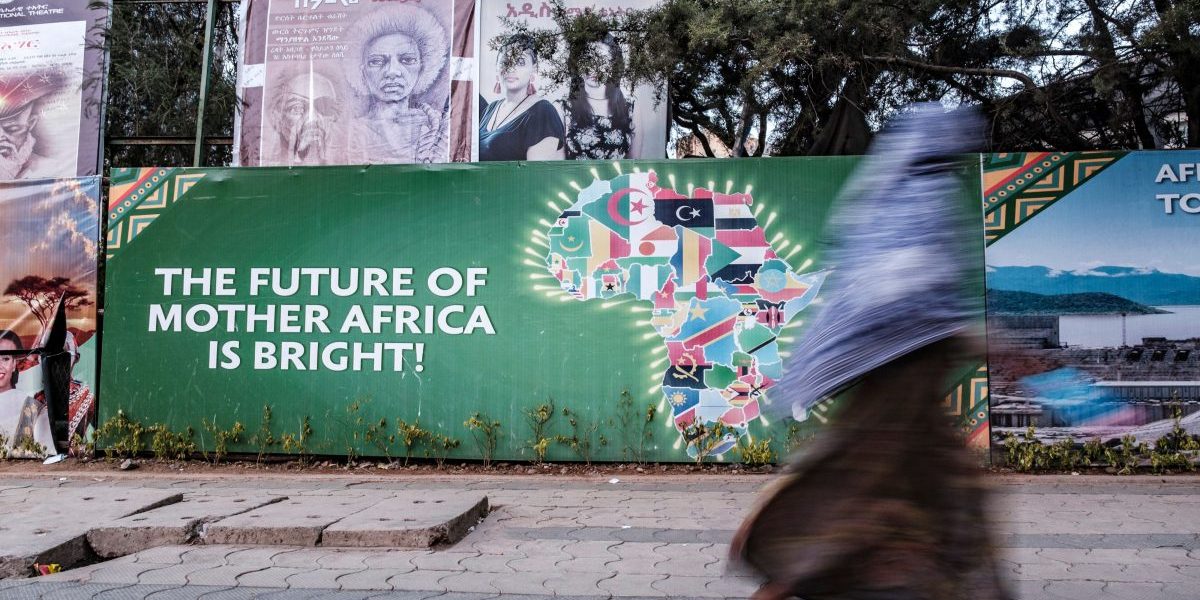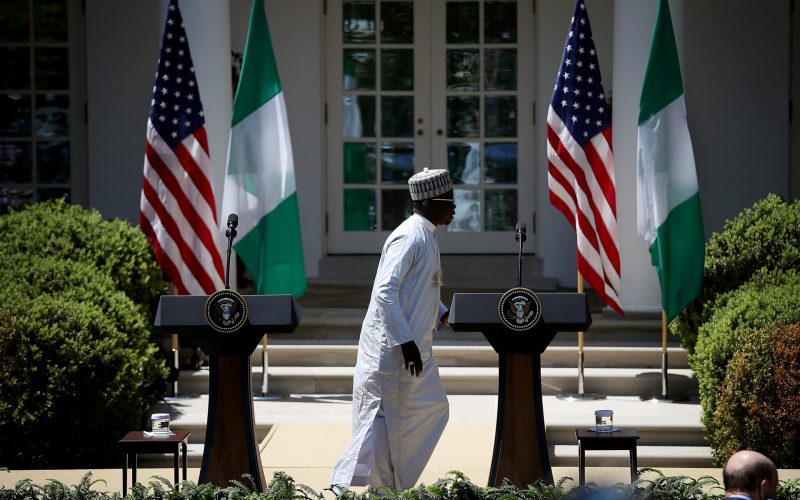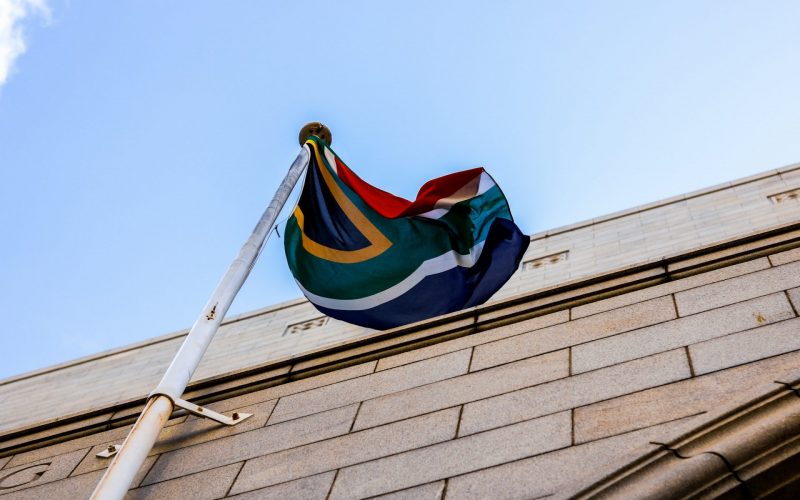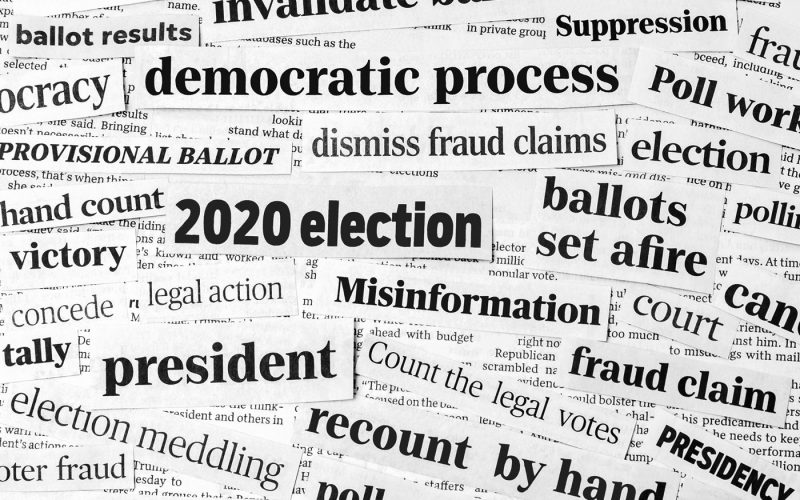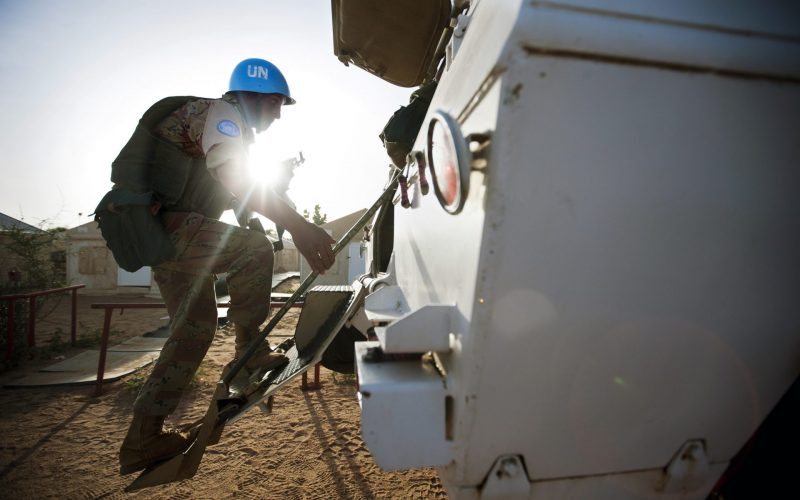Recommendations
- Encourage universal (voluntary) accession to the African Peer Review Mechanism (APRM) across the continent since, statistically, APRM member states are more likely to practise good governance than non-member states.
- Revisit the effectiveness of existing AU mechanisms in driving good governance, including looking for evidence of duplication of effort.
- Shift the focus of these mechanisms from the mere provision of recommendations to the standard uptake and implementation of such recommendations.
Executive Summary
Good governance has been a priority of the African Union for many years and features strongly in its Agenda 2063. Yet it is a difficult concept to define and measure. To overcome this problem, the African Union has introduced different processes and instruments aimed at promoting good governance among member states, including the African Peer Review Mechanism (launched in 2003) and the African Governance Report (first published in 2019). This policy brief takes stock of the state of governance in Africa, according to various indices, with a view to determining the relative effectiveness of these two mechanisms in driving good governance on the continent.
Although the African Peer Review Mechanism has seen steady growth in membership in its 20 years of existence, its impact on Africa’s governance trajectory has not been overwhelming. Similarly, the African Governance Report, although a more recent instrument, has so far failed to make a noticeable difference to the quality of governance in Africa. In fact, governance standards on the continent have either remained static or have declined.
Introduction
Governance – the way rules are followed – is an area of frequent concern among policymakers and scholars globally. In an African context, concerns have escalated since the release of the 1981 Berg Report commissioned by the World Bank, which concluded that poor governance was a major contributor to Africa’s poor economic health.1The World Bank, ‘Accelerated Development in Sub-Saharan Africa: An Agenda for Action,’ (1981).
Good governance has been a key priority of the African Union (AU) since its transformation from the Organisation of African Unity (OAU) in 2002. According to the AU Constitutive Act, one of the AU’s objectives is to ‘promote democratic principles and institutions, popular participation and good governance’.2African Union, ‘Constitutive Act of the African Union‘ (2000 – Lome, Togo), Article 3, (G), 3 Meanwhile, Agenda 2063: The Africa We want, which is the AU’s ‘master plan for transforming Africa into the global powerhouse of the future’,3African Union, ‘Agenda 2063: The Africa We Want.’ includes good governance, democracy, respect for human rights, justice and the rule of law among its seven aspirations.4African Union Commission, ‘Agenda 2063: The Africa We Want’ (September 2015), 2.
Notwithstanding its clear importance, governance is a notoriously difficult concept to define and quantify. Yet several tools have been developed specifically for this purpose. The Worldwide Governance Indicators (WGI), a World Bank initiative, were launched in 1996 to provide comparable scores, in the form of an index, for over 200 countries across six dimensions of governance, namely: control of corruption; government effectiveness; political stability and absence of violence; regulatory quality; rule of law; and voice and accountability.5Pranish Desai, ‘Data is a vital tool to help uplift societies,’ Mail & Guardian, October 7, 2022 The index draws from several sources, including the Afrobarometer, which conducts multi-country public attitude surveys on democracy, governance, the economy and society,6Afrobarometer, ‘What do we do.’ and the Mo Ibrahim Foundation’s Ibrahim Index of African Governance (IIAG), which is an assessment tool focusing on governance performance in 54 African countries.7Mo Ibrahim Foundation, ‘Ibrahim Index of African Governance (IIAG).’
The African Development Bank (AfDB) asserts that good governance has five key elements: (1) accountability, (2) transparency, (3) measures to combat corruption, (4) stakeholder participation, and (5) a legal and judicial framework.8African Development Bank, ‘Bank Group Policy on Good Governance’ (November 1999), 3 It further argues that good governance is an imperative for creating and sustaining an enabling environment for development. In other words, good governance is only one of Africa’s collective aspirations, but without it, many of the others are unachievable.
This policy brief takes stock of the state of governance in Africa, drawing on various governance indicators and reports. It also reflects on the AU instruments and processes put in place to promote and monitor good governance, such as the African Peer Review Mechanism (APRM) (including what the data reveals about the mechanism’s efficacy after 20 years of operation), and newer AU tools, such as the Africa Governance Report (AGR) which was first published in 2019.
State of (good) governance in Africa
What is the state of (good) governance on the African continent and is the continent on a positive trajectory in this regard?
A superficial examination shows that governance on the continent seems to have improved over the last decade. According to the 2022 IIAG report, ‘more than half of Africa’s population lives in a country where overall governance has improved between 2012 and 2021’.9Mo Ibrahim Foundation, ‘2022 Ibrahim Index of African Governance: Index Report,’ January 2023, 14 However, a more comprehensive inspection reveals a much less positive trajectory.
It is concerning that since 1996, when WGI data was published for the first time (see Figure 1), the continent’s average estimated scores for most dimensions – except voice and accountability – have shown a negative trend. Estimated scores range from approximately -2.5 (weak) to 2.5 (strong) governance performance, with the extent of overall change differing per dimension. Control of corruption, regulatory quality and rule of law have shown less than a 0.1-point decrease (ie, decreases of -0.08, -0.07, -0.02 points respectively). Political stability and government effectiveness have shown decreases of -0.18 and -0.11 points respectively. Voice and accountability have shown a slight, 0.08-point increase.
The slight positive trajectory of voice and accountability across the continent, when compared to decreasing trends across the other five dimensions may indicate that, at a broad level, the AU’s mechanisms to promote good governance are succeeding in enabling citizens to contribute to the governance discussion on the continent. Yet this has not translated into better governance all round.
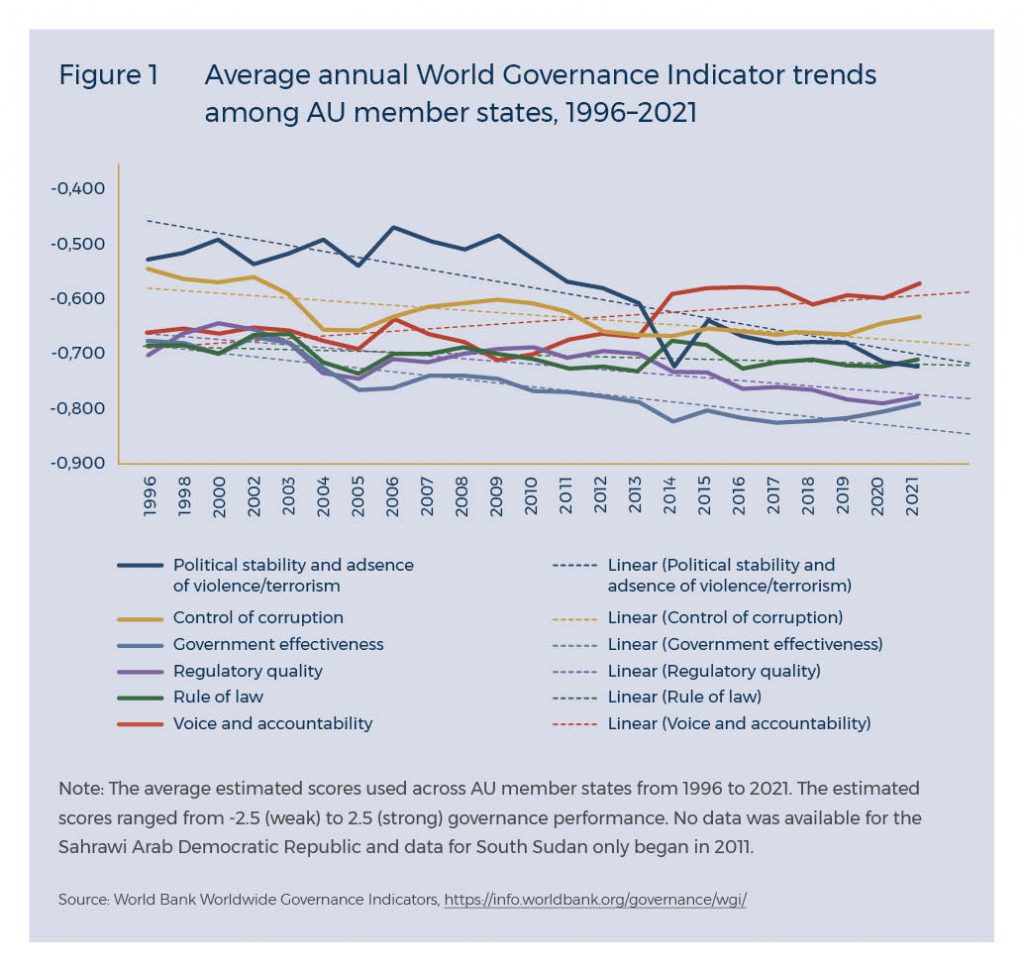
The overall trend in African governance over the past decade has been somewhat mixed, with some indices reflecting progress and others reflecting stagnation. For example, the WGI average indicators may show that the continent is on a slightly upward trajectory at present. However, other indicators, such as the IIAG, show that since 2019, no progress in overall governance has been recorded.10Mo Ibrahim Foundation, ‘2022 Ibrahim index,’ 14. The 2022 IIAG report argues that Covid-19 has had a decisive impact on the continent’s overall progress. It notes with concern that some countries – Burkina Faso, Eswatini, Guinea, Guinea-Bissau, Liberia, Madagascar, Namibia and Rwanda – have lost previous gains or halted their progress completely.11Mo Ibrahim Foundation, ‘2022 Ibrahim index,’ 15
A 2022 Economist Intelligence Unit (EIU) report shows similar stagnation in progress across the continent. The EIU Democracy Index 2022 report notes a marginal, 0.02-point improvement in the Sub-Saharan African region in the last year, from 4.14 (on a 0–10 scale).12The Economist Intelligence Unit, ‘Democracy Index 2022: Frontline democracy and the battle for Ukraine,’ 2023, 56. The continent still boasts only one ‘full democracy’ – Mauritius – and six ‘flawed democracies’ – Botswana, Cabo Verde, Ghana, Lesotho, Namibia and South Africa,13The Democracy Index defines full democracies as countries in which not only basic political freedoms and civil liberties are respected but which also tend to be underpinned by a political culture that allows democracy to flourish. Flawed democracies have free and fair elections and, even when faced with problems, respect basic civil liberties; The Economist Intelligence Unit, Democracy Index 2022, 55, 56, 67. a picture that has remained unchanged since 2021. The rest of the region comprises mostly authoritarian regimes.14The Economist Intelligence Unit, Democracy Index 2022, 55 Accordingly, the continent as a whole does not appear to have made significant gains in good governance since the turn of the century. Furthermore, the 2022 IIAG report raises questions about the resilience of the continent to withstand future shocks.15Mo Ibrahim Foundation, ‘2022 Ibrahim index,’ 15. Notable shocks were observed both in 2004 and 2015 across most of the dimensions.
It is not immediately clear what caused the notable decreases across indicators in 2004 and 2015. However, the data suggests that in most cases, they were caused by a relatively significant drop in scores of a few countries compared to the continental average. For example, from 2003 to 2004, Gabon saw a drop in regulatory quality (a -0.3 change compared to a 0.035 average change across the continent), rule of law (a -0.3 change compared to a 0.043 average change across the continent) and control of corruption (a -0.5 change compared to a 0.055 average change across the continent). These dramatic relative drops could have been caused by the high-profile corruption trials in France in 2003, involving the TotalFinaElf oil company which exposed the corrupt activities, carried out on a global scale, of Gabon’s president, Omar Bongo.
Furthermore, the major decline in political stability from 2013 to 2014 was caused by a dramatic drop in several countries’ scores, with five states – Central African Republic, Djibouti, Libya, South Sudan and Tunisia – recording a more than 0.5-point drop. This was likely triggered by the eruption or worsening of civil wars in South Sudan, Central African Republic and Libya or, alternatively, heightened civil unrest in Djibouti and Tunisia, which was met with increased repression by the state.
Identifying the likely causes of each notable drop in governance scores over the two-decade period is beyond the scope of this policy brief. However, it is important to note that after each drop, most countries struggled to regain their lost points. If they did manage to make positive progress, it was short lived. This signals a lack of resilience in governance on the continent, a worrying trend that requires further attention.
Is either the APRM or AGR making a difference?
The APRM, established in 2003, is a voluntary governance self-assessment and promotion tool, described as ‘Africa’s unique and innovative approach to governance’. It aims to improve ‘governance dynamics at the local, national and continental levels’.16African Peer Review Mechanism, ‘About the APRM.’ As a voluntary instrument, the APRM has slowly been adopted by AU member states (43 out of 55 members had acceded as at 1 May 2023) but is yet to realise the envisaged ‘universal accession’ (ie, continent-wide membership) by the end of 2023.17As of 2023, the following countries are APRM member states (review category indicated): member, no review: Algeria, Angola, Botswana, Burundi, Cameroon, Democratic Republic of Congo, Equatorial Guinea, Gabon, Gambia, Malawi, Mauritania, Sao Tome and Principe, Seychelles, Togo, Tunisia, Zimbabwe; one review: Benin, Burkina Faso, Chad, Côte d’Ivoire, Ethiopia, Egypt, Ghana, Lesotho, Liberia, Mali, Mauritius, Niger, Rwanda, Senegal, Sudan, Tanzania; two reviews: Mozambique, Nigeria, South Africa, Uganda; targeted review: Comoros, Djibouti, Namibia, Sierra Leone, Zambia; two reviews and targeted review: Kenya. The voluntary nature of the mechanism and varying levels of political will have resulted in some members having undergone the review process and some having even undergone two reviews or a targeted review. Meanwhile, some longstanding members have not undergone any review at all.
How effective has the APRM been over the past 20 years? From the above discussion, it is clear that governance in Africa has not greatly improved across the board. But does the data pertaining to APRM members, especially those that have undergone reviews, tell a different story?
In 2014, the South African Institute of International Affairs (SAIIA) published a paper titled ‘The state of governance in Africa: what indices tell us’.18Yarik Turianskyi, ‘The state of governance in Africa: what indices tell us,’ (Occasional Paper 232, South African Institute of International Affairs, Johannesburg), 2016. It tracked the governance progress of 52 African countries, in terms of various indices, to ascertain if the APRM had made a difference. The paper concluded that, overall, APRM members had performed better than non-members. Yet the fact that a member had undergone a review did not seem to make a marked difference. Since the SAIIA paper was published, the membership of the APRM has grown from 35 to 43 and the number of countries that have undergone at least one review has increased from 17 to 26. Moreover, some countries have undergone two reviews and even targeted reviews. It is therefore a good time to again establish the APRM’s impact on African governance according to various indicators.
The 2022 IIAG report provides a 10-year trend classification for the period 2012–2021 which helps to analyse the direction and pace of a country’s governance trajectory, ranging from slower or faster deterioration to slower or faster improvement. Although there is a diversity of trends among APRM members and non-members alike (see Table A1 in Annexure A), one notable observation is that an APRM member (regardless of the number of reviews undergone) has a one-in-three (33.33%) chance of experiencing ‘increasing improvement’ across its 10-year trend classification, whereas non-members have only an 8.3% chance of achieving this trend classification. In addition, the number of reviews that a member has undergone does not seem to improve its chances of falling into this classification. For example, a member that has undergone at least one review has a 17% chance (on average) and a member that has not undergone any review has a 53.3% chance (on average) of experiencing an ‘increasing improvement’ trend. This correlates with the findings from the previous SAIIA study.

Neither the singular factor of APRM membership nor the number or type of reviews that a member has undergone seems to have had a definitive impact on a country’s governance scores. Some members that have undergone one review show a 10-year trend of accelerating improvement, such as Ethiopia, Sudan and Tanzania. In contrast, Benin, Egypt, Mali, Mauritius and Niger have also undergone one review and yet show a 10-year trend of increasing deterioration.
According to some observers, one of the APRM’s limitations is that ‘many APRM recommendations are simply ignored’.19Steven Gruzd, ‘The African Peer Review Mechanism at 20 – Good governance remains an unevenly met goal,’ Daily Maverick, March 16, 2023. Yet other studies have indicated that civil society involvement has been one of the major driving forces behind successful APRM interventions.20Yarik Turianskyi and Steven Gruzd, ‘Maintaining Momentum: Civil Society and the APRM in Zambia,’ (Policy Briefing 114, SAIIA, Johannesburg, 2014), 2. Although more research is required to reveal the definitive causes of APRM successes and failures, it is clear that the current APRM process does not guarantee improved governance; if it is to do so, it will need revisions.
In 2017, the AU unveiled the AGR to ‘strengthen the capacity of the APRM to deliver on its expanded mandate and enhance its functional autonomy’.21African Peer Review Mechanism, ‘The African Governance Report: Promoting African Union shared values,’ January 2019, 10. However, the two AGR reports produced thus far have focused on ‘[providing] relevant, accurate and informative assessments and reports on select and key governance areas in all 55 Member States of the AU’.22The African Union, ‘The Africa Governance Report 2021,’ 2021, 13. Although performing a necessary task, the AGR risks duplicating the work of the APRM in conducting its reviews using existing governance indicators, as discussed in this report. More importantly, this process of reflection could fall short in terms of increasing the effectiveness and autonomy of the APRM, in line with its original mandate.
Conclusion: Where to from here?
According to WGI data, the African continent has not, on average, made significant strides in improving governance over the past two decades. Instead, there has been an overall decline in governance scores in five out of the six dimensions. Furthermore, the gains in overall governance across the continent over the past decade have stalled and, in some cases, have reversed. These trends are concerning and require a consolidated effort across the continent to transition towards a more positive continent-wide trajectory.
Although the average continent-wide governance scores are worrying, some states have realised impressive, positive trends over the past decade, including Angola, Botswana, Djibouti, Equatorial Guinea, Ethiopia, Gabon, Malawi, Mauritania, Morocco, Seychelles, Sierra Leone, South Africa, Sudan, Tanzania and Tunisia. This policy brief found that, on average, these states are more likely to be APRM members. The voluntary nature of the review mechanism, though, makes it difficult to definitively determine whether being a member of the APRM improves its scores or whether a state with a good governance track record is more likely to join such a mechanism. The fact that the APRM is voluntary also means that member states can choose whether or not to undergo the review process. Nonetheless, an underlying expectation of the APRM is that if states willingly submit to the review process, they will choose to become more effectively governed over time.23Newell Stultz, ‘African States Experiment with Peer-Reviewing,’ The Brown Journal of World Affairs 13, no. 2 (2007): 247–257. Therefore, the goal to achieve (voluntary) universal accession to the APRM should be supported and member states should be further encouraged to undergo the review process.
It is important to take stock of Africa’s long-term and short-term governance trajectory in the light of the continent’s ambitious development goals, such as Agenda 2063 and the fast-approaching UN Sustainable Development Goals 2030. It is also important to review the impact of the mechanisms put in place, such as the APRM and the AGR, in steering the continent’s governance in the direction of these goals. The APRM has reportedly involved a $48.8 million investment between 2003 and 2018,24Gruzd, ‘The African Peer Review.’ yet its positive impact on governance on the continent has not delivered a significant return on this investment. Although the AGR is a much more recent development, its first three reports mention the same roadblock as that encountered in the APRM reviews. Therefore, while well researched and insightful, these mechanisms’ recommendations remain just that.
Governance data shows that, in general, African citizens feel that their views are being heard in governance discussions; yet their contributions are not translating into improved governance. This disjuncture threatens the achievement of Africa’s good governance ambitions in the long run. The above-mentioned governance mechanisms’ cost structures and return on investment therefore need to be adapted to ensure that they propel the continent towards the achievement of its long-term goals and do not simply duplicate existing efforts to measure progress (or the lack thereof). The focus should shift towards the routine adoption of the recommendations emanating from the respective reports.
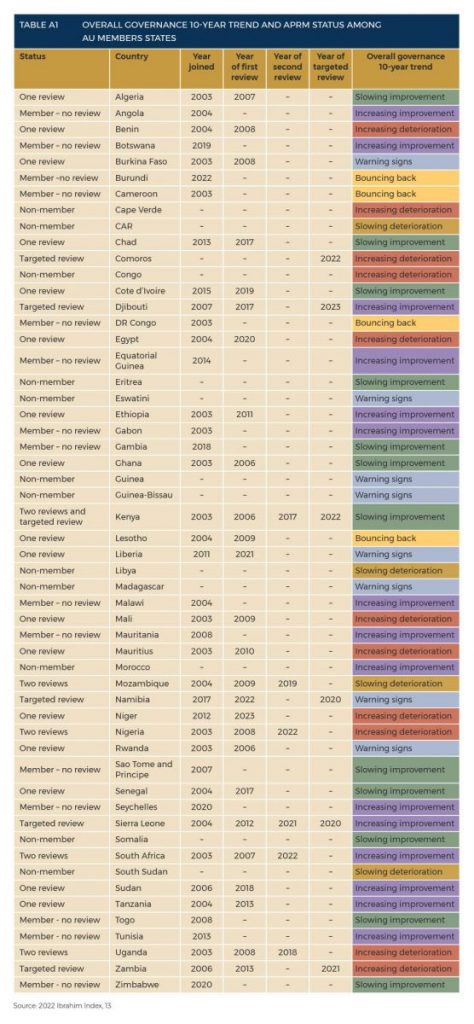
Acknowledgement
SAIIA would like to thank the Swedish International Development Cooperation Agency for their generous support of this work.

